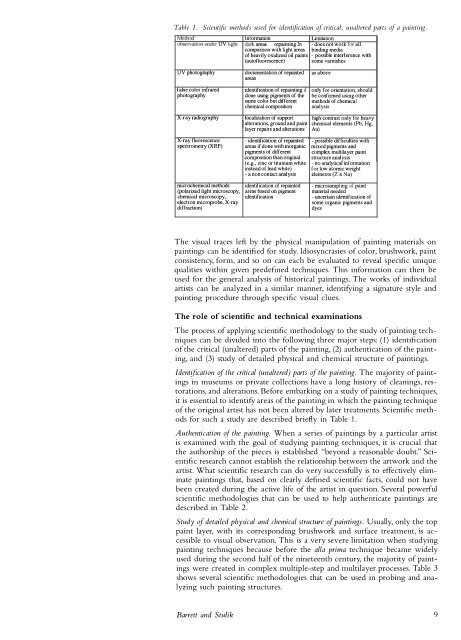Historical Painting Techniques, Materials, and Studio Practice
You also want an ePaper? Increase the reach of your titles
YUMPU automatically turns print PDFs into web optimized ePapers that Google loves.
Table 1. Scientific methods used Jo r identification oj critical, unaltered parts oj a painting.<br />
M ethod In ormation LimitalJon<br />
observatIOn under UV light I dark areas of repamlJng III - does not worK lor all<br />
comparison wilh light areas<br />
binding media<br />
of heavily oxidized oil paints - possible interference with<br />
(autofluorescence)<br />
some varnishes<br />
UV photography documentation of repainted as above<br />
areas<br />
false color infrared<br />
identification of repainting if only for orientation, should<br />
photography done using pigments of the be confirmed using other<br />
same color but different methods of chemical<br />
chemical composition analysis<br />
X -ray radiography localization of support high contrast only for heavy<br />
alterations, ground <strong>and</strong> paint chemical elements (Pb, Hg,<br />
layer repairs <strong>and</strong> alterations Au)<br />
X-ray f1uorescence - identification of repainted - possible difficulties with<br />
spectrometry (XRF) areas if done with inorganic mixed pigments <strong>and</strong><br />
pigments of different complex multilayer paint<br />
composi tion than original structure analysis<br />
(e.g., zinc or titanium white - no analytical information<br />
instead of lead white) for low atomic weight<br />
- a non contact analysis elements (Z :$ Na)<br />
microchemIcal methods Identification of repainted - microsampling 01 paint<br />
(polarized light microscopy, areas based on pigment material needed<br />
chemical microscopy, identification - uncertain identification of<br />
electron microprobe, X-ray<br />
some organic pigments <strong>and</strong><br />
diffraction)<br />
dyes<br />
The visual traces left by the physical manipulation of painting materials on<br />
paintings can be identified fo r study. Idiosyncrasies of color, brushwork, paint<br />
consistency, form, <strong>and</strong> so on can each be evaluated to reveal specific unique<br />
qualities within given predefined techniques. This information can then be<br />
used for the general analysis of historical paintings. The works of individual<br />
artists can be analyzed in a similar manner, identifYing a signature style <strong>and</strong><br />
painting procedure through specifiC visual clues.<br />
The role of scientific <strong>and</strong> technical examinations<br />
The process of applying scientific methodology to the study of painting techniques<br />
can be divided into the following three major steps: (1) identification<br />
of the critical (unaltered) parts of the painting, (2) authentication of the painting,<br />
<strong>and</strong> (3) study of detailed physical <strong>and</strong> chemical structure of paintings.<br />
Identification oj the critical (unaltered) parts of the painting. The majority of paintings<br />
in museums or private collections have a long history of cleanings, restorations,<br />
<strong>and</strong> alterations. Before embarking on a study of painting techniques,<br />
it is essential to identifY areas of the painting in which the painting technique<br />
of the original artist has not been altered by later treatments. Scientific methods<br />
for such a study are described briefly in Table 1.<br />
Authentication oj the painting. When a series of paintings by a particular artist<br />
is examined with the goal of studying painting techniques, it is crucial that<br />
the authorship of the pieces is established "beyond a reasonable doubt." Scientific<br />
research cannot establish the relationship between the artwork <strong>and</strong> the<br />
artist. What scientific research can do very successfully is to effectively eliminate<br />
paintings that, based on clearly defined scientific facts, could not have<br />
been created during the active life of the artist in question. Several powerful<br />
scientifiC methodologies that can be used to help authenticate paintings are<br />
described in Table 2.<br />
Study of detailed physical <strong>and</strong> chemical structure of paintings. Usually, only the top<br />
paint layer, with its corresponding brushwork <strong>and</strong> surface treatment, is accessible<br />
to visual observation. This is a very severe limitation when studying<br />
painting techniques because before the alia prima technique became widely<br />
used during the second half of the nineteenth century, the majority of paintings<br />
were created in complex multiple-step <strong>and</strong> multilayer processes. Table 3<br />
shows several scientific methodologies that can be used in probing <strong>and</strong> analyzing<br />
such painting structures.<br />
Barrett <strong>and</strong> Stulik 9


